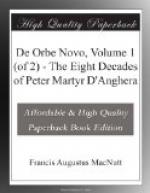When the barbarians withdrew from the coast, the Spaniards entered their boios, that is to say their houses. The natives frequently attacked our men with fury, seeking to kill them all with flights of poisoned arrows. When they realised that their houses were to be invaded and robbed, and particularly when they witnessed their women and the majority of their children carried into captivity, their fury increased. The furniture found in these houses was discovered to be made of large reeds gathered along the shore, or of various grasses resembling cords. Woven mats of various colours, and cotton hangings, upon which lions, eagles, tigers, and other figures were executed with great care and taste, were found. The doors of the houses and of the rooms inside were hung with snail-shells strung upon fine cord, which the wind easily shook, producing a noise of rattling shells which delighted them.
From various sources astonishing tales of the natives have been told me. Amongst others, Gonzales Fernando Oviedo,[5] who is a royal official with the title of inspector, boasts that he has travelled extensively in the interior of the country. He found a piece of sapphire larger than a goose’s egg, and upon the hills he explored with about twenty men, he claims that he has seen a large quantity of emerald matrix, chalcedon, jasper, and great lumps of mountain amber.
[Note 5: Sommario dell’Indie Occidenti, cap. lxxxii., in Ramusio.]
Attached to the tapestries woven with gold which the Caribs left behind them in their houses when they fled, were precious stones: Oviedo and his companions affirm that they saw them. The country also has forests of scarlet wood and rich gold deposits. Everywhere along the coast and on the banks of the rivers exist marcasites[6] which indicate the presence of gold. Oviedo further states that in a region called Zenu, lying ninety miles east of Darien, a kind of business is carried on for which there are found in the native houses huge jars and baskets, cleverly made of reeds adapted to that purpose. These receptacles are filled with dried and salted grasshoppers, crabs, crayfish, and locusts, which destroy the harvests. When asked the purpose of these provisions, the natives replied they were destined to be sold to the people inland, and in exchange for these precious insects and dried fish they procure the foreign products they require. The natives live in scattered fashion, their houses not being built together. This land, inhabited by the people of Caramaira, is an Elysian country, well cultivated, fertile, exposed neither to the rigours of winter nor the great heats of summer. Day and night are of about equal length.
[Note 6: A variety of iron pyrites.]
After driving off the barbarians, the Spaniards entered a valley two leagues in breadth and three long, which extended to the grassy and wooded slopes of the mountains. Two other valleys, each watered by a river, also open to the right and left at the foot of these mountains. One is the Gaira, and the other has not yet received a name. There are, in these valleys, cultivated gardens, and fields watered by ingeniously planned ditches. Our Milanese and Tuscans cultivate and water their fields in precisely the same manner.




